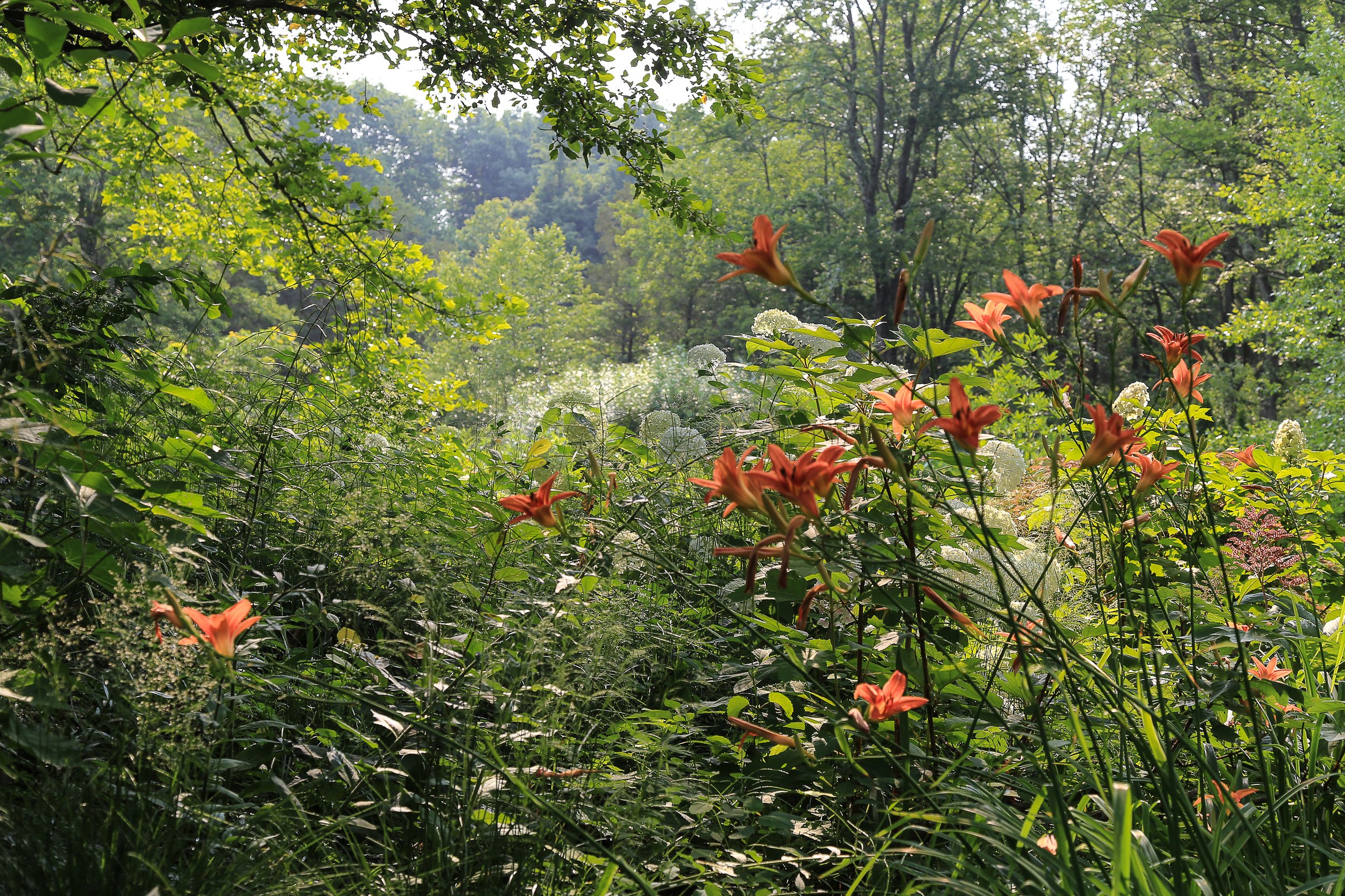
Filbert Stories
27/07/22
Q&A with James Golden author of The View from Federal Twist
Photographs by Izzy de Wattripont taken in the garden of Special Plants Nursery with thanks to Derry Watkins.
How did you come to gardens & gardening?
I have two answers to that question. The first has to do with early memories of landscape and plants. Although I didn’t garden in childhood, I do have rather powerful and intense memories of specific plants and landscapes. One of the first was a visual image. I was playing on a vacant lot planted with vetch. It was so tall, relative to me, that I could hide within it, looking up at lacy green walls of stem and foliage covered with purple, linear, almost “comb-like” flowers. I remember feeling peace, joy, and a powerful sense of protection. Also, a feeling of being transported to a new exciting place (although I was just 30 feet away from my family’s house). I think this was my earliest memory of plants.
I also remember driving across a highway bridge over a wetland created by Bear Creek just south of Canton, Mississippi, my home town. This was in autumn. Huge shrubs covered in fuzzy, white flowers were massed on the land below. I remember asking my father what they were but, of course, he didn’t know. This was typical of the dead ends I often encountered when asking about plants. Lack of knowledge, or even of a way to get that knowledge. Only many decades later did I learn the name, and the nature, of this plant: Bacharis halimifolia.
Landscapes, too, had a strong appeal. Cotton fields, in autumn, covered by the browns and whites of fuzzy ripe cotton, made beautiful monocultural landscapes. And the town cemetery, visible from my childhood house, became my first experience of a park—not really a park, but the only park-like place I knew. It was full of old monuments, even a columbarium where the remains of those who died in a yellow fever epidemic were placed in the late nineteenth century. It was sort of a Gothic folly, though I’m sure I would not have had those words in my vocabulary at that time. And around the edges of that cemetery were wild hedgerows I could explore, secret places of wonder, all safely in my neighborhood, but isolated and alone.
My second answer is that I came to gardening through reading and books. This was much later in life, long after I moved from my childhood home in Mississippi to New York City. We had a brownstone rowhouse in Brooklyn with a small back garden space. That I would not make some kind of garden there wasn’t possible. I can’t really account for why I know I wanted to make a garden. It was simply a given. The space was small, about 16-feet wide and 30-feet long. I suppose I must have read some “how to” books to get started, but the first book I remember is Christopher Lloyd’s The Well Tempered Garden—certainly not a “how to” book, but a book of mysteries, mysteries because so much of what I read was new to me, some I didn’t have the knowledge to understand, but it presented a tantalizing goal, and it began my first serious introduction to the world of gardens.
What is the value in gardening?
As a place to find meaning, at least for me. A place for thought, feeling, exploration of the non-physical world. A respite, a refuge.
How would you describe the sense of place at Federal Twist?
Mysterious (or I would like to think so.) A place to lose yourself.
How does ecology relate to your garden?
The ecology of my site—heavy, wet clay—dictates the kind of garden I have. I can only grow plants adapted to grow in heavy, wet clay and it so happens that many of these plants are large and highly competitive. My garden site is a clearing in the woods, so it is a woodland edge habitat. Only after finding a copy of the book Perennials and their Garden Habitats by Richard Hansen and Friedrich Stahl did I come to understand the richness of woodland edge, the importance of plant sociology, and ways to intermingle plants with varied characteristics.
Is there anything new you will be planting this year?
I plant new things every year. I’m always experimenting to better understand what will grow in my difficult conditions. Of late, I’ve been exploring use of many different native Carex. These are usually only available as small plug plants, so this is necessarily a multiyear process.
I’ve also begun a project to make use of dead wood from our ash trees, which have all died from infection by the Emerald Ash Borer, an Asian insect that has killed thousands of mature ash trees in our area. I’m using some of the wood in a Hugelkultur experiment—placing it in a woodland area in front of my house, covering it with soil, and waiting for the wood to decompose, forming a soft, pliable soil suitable for spring ephemerals and other shade plants. My goal is to emulate a forest floor, but to do that using mainly various Carex and ferns. This too is a long-term, multiyear project.
What is the next book you plan to read?
I’m always reading, so I’m already reading the next book. It’s The World According to Garp, one of the few John Irving novels I haven’t read. I’m also reading Wild: The Naturalistic Garden by Noel Kingsbury and Clair Takacs, and Tom Stuart-Smith: Drawing from the Land by Tim Richardson.
Who's the most interesting gardener you've come across recently?
I look at the growing numbers of young people choosing to work in the gardening world. That is a hopeful sign.
What part of the world would you most like to explore?
Italy, Italy, Italy. I’d love to make a Mediterranean garden in Italy.
How do you see the future of gardens & gardening?
I find it hard to be hopeful about the future. The political movement of the world and my own country toward fascism, and the nightmare of climate change leave me with little hope. Gardens may still be places of rest and refuge but, as in The Garden of the Finzi-Continis, the protective wall will be breached, eventually.
The View from Federal Twist by James Golden








